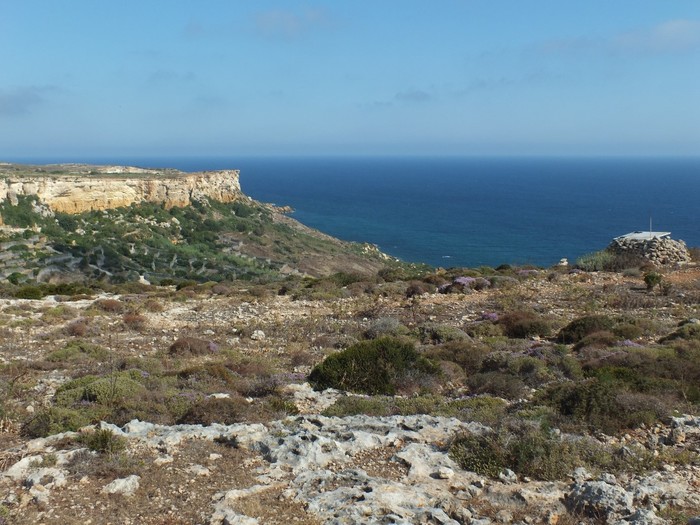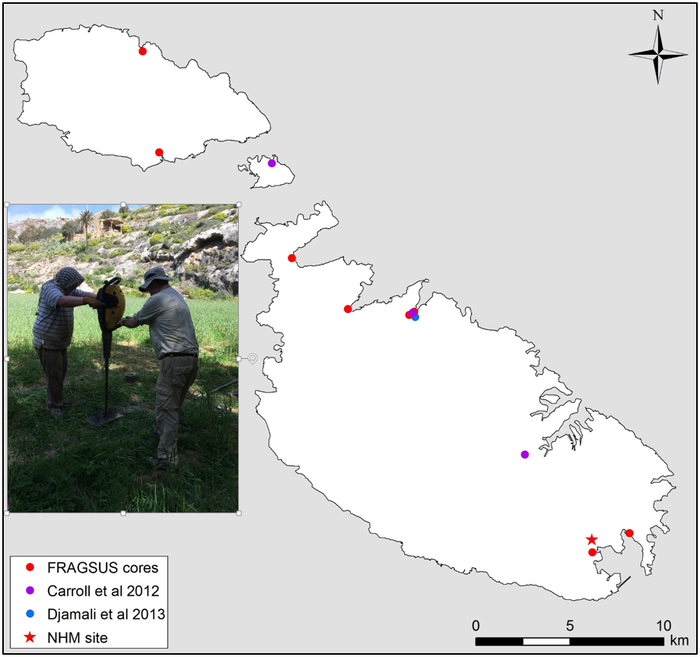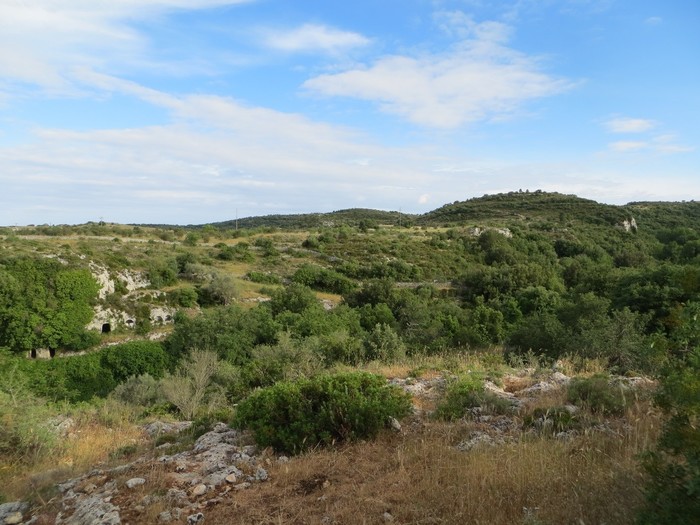Current work
Pollen taphonomy of shallow estuarine environments in Malta

Figure 1 The Maltese landscape.
In the karstic, semi-arid environment of the Maltese Islands ‘conventional’ palynological archives such as lakes and bogs, for which taphonomic processes are relatively well understood, do not exist. The FRAGSUS cores were recovered from coastal sediments and have largely accumulated under shallow estuarine conditions. To investigate the pollen taphonomy of these sites, benthic sediment samples were collected within estuaries of differing catchment size in northern Malta. Surface soil samples were also taken from several different vegetation types present within these catchments in order to determine whether the estuarine samples provide a homogenised, regional picture of vegetation cover or reflect more local conditions.

Figure 2 Coring sites on Malta and Gozo.
Quantitative reconstruction of past vegetation cover
Interpretation of pollen assemblages is not straightforward due to differences in pollen productivity and dispersal mechanisms between taxa. In an attempt to overcome these difficulties, considerable recent research effort has been invested in the development of process-based modelling approaches to reconstruction of past vegetation cover from pollen assemblages (Gaillard et al. 2008). These techniques use algebraic models of the taphonomic process linking pollen assemblages with the vegetation that produces them to translate pollen data into quantitative measures of vegetation cover (Sugita 2007a; 2007b; Bunting and Middleton 2009).
An essential pre-requisite for application of these modelling approaches is to have estimates of Relative Pollen Productivity (RPP) for the taxa of interest. RPP estimates for several northern European taxa are available (Broström et al. 2008), but to date there are no published estimates of RPP for Mediterranean taxa. Estimates of RPP can be extracted from extended R-value analysis (Parsons and Prentice 1981) using comparisons between modern pollen assemblages and measurements of the present-day vegetation cover around the sampling point. To estimate RPP for a given taxon it must be present at most of the sampling sites, and at a range of values in both the pollen and vegetation datasets. Land-use in Malta today is highly urbanised and agricultural, and the range of semi-natural vegetation communities present on Malta today is somewhat limited, mainly comprising degraded garrigue and maquis. There is presently very little woodland in Malta, and therefore estimation of RPP for arboreal taxa is not possible from the Maltese surface sample dataset.
To overcome these problems, fieldwork has been carried out in south-eastern Sicily, where semi-natural vegetation is still reasonably well-preserved. This area of Sicily is part of the same limestone plateau as Malta, and is environmentally very similar, so estimates of RPP obtained from data collected here will be applicable to reconstruction of the Neolithic vegetation cover of the Maltese Islands. The fieldwork was led by Michelle Farrell, with assistance from a team of palynologists and botanists who are working to apply these techniques in other Mediterranean environments. The team included Helen Shaw (University of Wales Trinity Saint David), Julien Azuara (HNHP UMR 7194 CNRS, Muséum national d’Histoire naturelle), Nicolas de Munnik (Université de Toulouse Jean Jaurès), Graciela Gil-Romera (Instituto Pirenaico de Ecología – CSIC) and Laura Sadori (Sapienza Università di Roma).

Figure 3 Fieldwork on Sicily- 2015 season.
Broström, A., Nielsen, A.B., Gaillard, M.-J., Hjelle, K., Mazier, F., Binney, H., Bunting, J., Fyfe, R., Meltsov, V., Poska, A., Räsänen, S., Soepboer, W., von Stedingk, H., Suutari, H., Sugita, S. (2008) Pollen productivity estimates of key European plant taxa for quantitative reconstruction of past vegetation: a review. Vegetation History and Archaeobotany 17 461-478.
Bunting, M.J., Middleton, R. (2009) Equifinality and uncertainty in the interpretation of pollen data: the Multiple Scenario Approach to reconstruction of past vegetation mosaics. Holocene 19 799-803.
Gaillard, M.-J., Sugita, S., Bunting, M.J., Middleton, R., Broström, A., Caseldine, C., Giesecke, T., Hellman, S.E.V., Hicks, S., Hjelle, K., Langdon, C., Nielsen, A.B., Poska, A., von Stedingk, H., Veski, S., POLLANDCAL members (2008) The use of modelling and simulation approach in reconstructing past landscapes from fossil pollen data: a review and results from the POLLANDCAL network. Vegetation History and Archaeobotany 17 419-443.
Parsons, R.W., Prentice, I.C. (1981) Statistical approaches to R-values and the pollen-vegetation relationship. Review of Palaeobotany and Palynology 32 127–152.
Sugita, S. (2007a) Theory of quantitative reconstruction of vegetation I: pollen from large sites REVEALS regional vegetation composition. Holocene 17 229-241.
Sugita, S. (2007b) Theory of quantitative reconstruction of vegetation II: all you need is LOVE. Holocene 17 243-257.